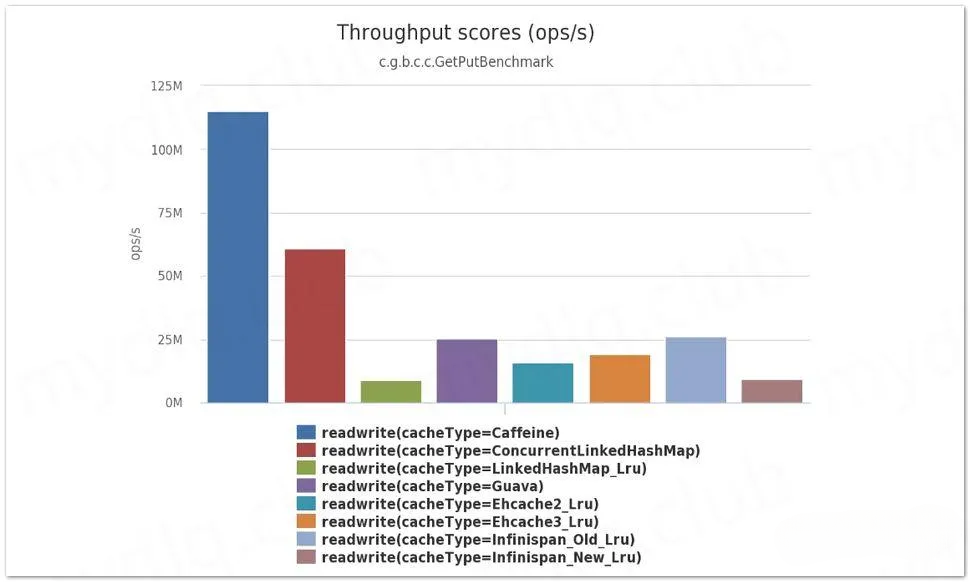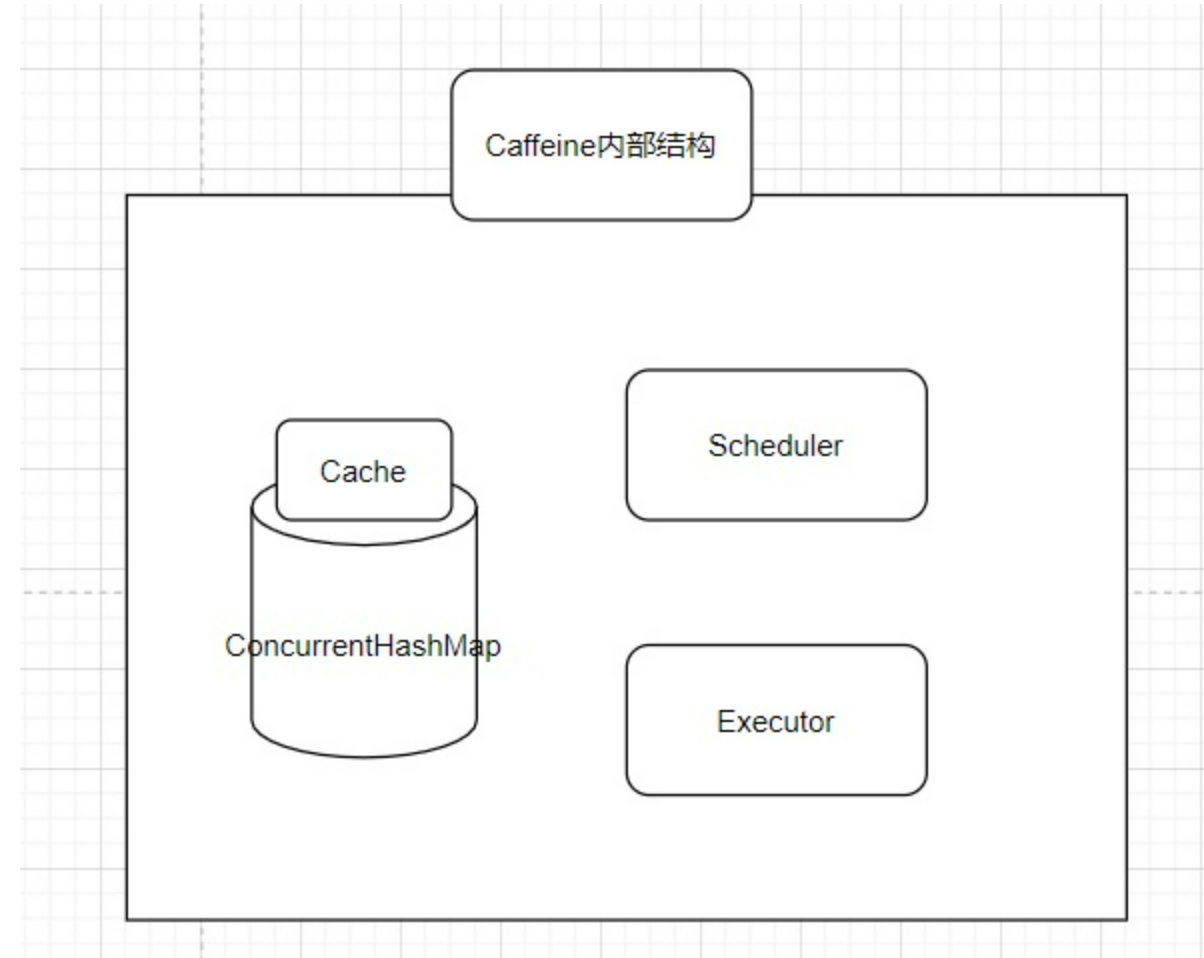 Java 的高性能缓存库-caffeine!
Java 的高性能缓存库-caffeine!
在项目中用到的除了分布式缓存,还有本地缓存,例如:Guava、Encache,使用本地缓存能够很大程度上提升程序性能,本地缓存是直接从本地内存中读取,没有网络开销。
今天给大家介绍一个高性能的 Java 缓存库 -- Caffeine 。
# 简介
Caffeine是基于Java8 的高性能缓存库,借鉴了 Guava 和 ConcurrentLinkedHashMap 的设计经验,拥有更高的缓存命中率和更快的读写速度。
性能比Guava更强

数据结构

- Cache的内部包含着一个ConcurrentHashMap,这也是存放我们所有缓存数据的地方。
- Scheduler,定期清空数据的一个机制,可以不设置,如果不设置则不会主动的清空过期数据。
- Executor,指定运行异步任务时要使用的线程池。
# 功能特性
- 基于时间的回收策略:包括写入时间和访问时间
- 基于容量的回收策略:一种是基于容量大小,一种是基于权重大小,两者只能取其一。
- 基于数量回收策略
- 基于引用的回收策略:GC并且内存不足时,会触发软引用回收策略;GC并且内存不足时,会触发软引用回收策略。
- value自动封装弱引用或软引用
- 缓存访问统计
# 使用方式
引入依赖
<dependency>
<groupId>com.github.ben-manes.caffeine</groupId>
<artifactId>caffeine</artifactId>
</dependency>
1
2
3
4
2
3
4
手动创建缓存
Cache<Object, Object> cache = Caffeine.newBuilder()
//初始数量
.initialCapacity(10)
//最大条数
.maximumSize(10)
//PS:expireAfterWrite和expireAfterAccess同时存在时,以expireAfterWrite为准。
//最后一次写操作后经过指定时间过期
.expireAfterWrite(1, TimeUnit.SECONDS)
//最后一次读或写操作后经过指定时间过期
.expireAfterAccess(1, TimeUnit.SECONDS)
//监听缓存被移除
.removalListener((key, val, removalCause) -> { })
//记录命中
.recordStats()
.build();
cache.put("1","张三");
System.out.println(cache.getIfPresent("1"));
System.out.println(cache.get("2",o -> "默认值"));
1
2
3
4
5
6
7
8
9
10
11
12
13
14
15
16
17
18
19
2
3
4
5
6
7
8
9
10
11
12
13
14
15
16
17
18
19
自动添加缓存
LoadingCache<String, String> cache = Caffeine.newBuilder()
.maximumSize(10_000)
.expireAfterWrite(10, TimeUnit.MINUTES)
.build(new CacheLoader<String, String>() {
@Nullable
@Override
public String load(@NonNull String s) throws Exception {
System.out.println("load:" + s);
return "小明";
}
@Override
public @NonNull
Map<String, String> loadAll(@NonNull Iterable<? extends String> keys) throws Exception {
System.out.println("loadAll:" + keys);
Map<String, String> map = new HashMap<>();
map.put("phone", "188888888888");
map.put("address", "深圳");
return map;
}
});
//查找缓存,如果缓存不存在则生成缓存元素,如果无法生成则返回null
String name = cache.get("name");
System.out.println("name:" + name);
//批量查找缓存,如果缓存不存在则生成缓存元素
Map<String, String> graphs = cache.getAll(Arrays.asList("phone", "address"));
System.out.println(graphs);
1
2
3
4
5
6
7
8
9
10
11
12
13
14
15
16
17
18
19
20
21
22
23
24
25
26
27
2
3
4
5
6
7
8
9
10
11
12
13
14
15
16
17
18
19
20
21
22
23
24
25
26
27
异步加载缓存
AsyncLoadingCache<String, String> asyncLoadingCache = Caffeine.newBuilder()
//创建缓存或者最近一次更新缓存后经过指定时间间隔刷新缓存;仅支持LoadingCache
.refreshAfterWrite(1, TimeUnit.SECONDS)
.expireAfterWrite(1, TimeUnit.SECONDS)
.expireAfterAccess(1, TimeUnit.SECONDS)
.maximumSize(10)
//根据key查询数据库里面的值
.buildAsync(key -> {
Thread.sleep(1000);
return "hello world";
});
System.out.println("come in ");
//异步缓存返回的是CompletableFuture
CompletableFuture<String> future = asyncLoadingCache.get("1");
System.out.println(future.get());
1
2
3
4
5
6
7
8
9
10
11
12
13
14
15
16
2
3
4
5
6
7
8
9
10
11
12
13
14
15
16
# 缓存策略
/**
* 最大数量
* @throws InterruptedException
*/
@Test
public void maximumSizeTest() throws InterruptedException {
Cache<Integer, Integer> cache = Caffeine.newBuilder()
//超过10个后会使用LFU算法进行淘汰
.maximumSize(10)
.build();
for (int i = 1; i < 20; i++) {
cache.put(i, i);
}
Thread.sleep(500);//缓存淘汰是异步的
// 打印还没被淘汰的缓存
System.out.println(cache.asMap());
}
/**
* 权重淘汰
*/
@Test
public void maximumWeightTest() throws InterruptedException {
Cache<Integer, Integer> cache = Caffeine.newBuilder()
//限制总权重,若所有缓存的权重加起来>总权重就会淘汰权重小的缓存
.maximumWeight(100)
.weigher((Weigher<Integer, Integer>) (key, value) -> key)
.build();
for (int i = 1; i < 20; i++) {
cache.put(i, i);
}
Thread.sleep(500);//缓存淘汰是异步的
// 打印还没被淘汰的缓存
System.out.println(cache.asMap());
}
/**
* 访问后到期(每次访问都会重置时间,也就是说如果一直被访问就不会被淘汰)
*/
@Test
public void expireAfterAccessTest() throws InterruptedException {
Cache<Integer, Integer> cache = Caffeine.newBuilder()
.expireAfterAccess(1, TimeUnit.SECONDS)
.build();
cache.put(1, 2);
System.out.println(cache.getIfPresent(1));
Thread.sleep(3000);
System.out.println(cache.getIfPresent(1));//null
}
/**
* 写入后到期
*/
@Test
public void expireAfterWriteTest() throws InterruptedException {
Cache<Integer, Integer> cache = Caffeine.newBuilder()
.expireAfterWrite(1, TimeUnit.SECONDS)
.build();
cache.put(1, 2);
Thread.sleep(3000);
System.out.println(cache.getIfPresent(1));//null
}
1
2
3
4
5
6
7
8
9
10
11
12
13
14
15
16
17
18
19
20
21
22
23
24
25
26
27
28
29
30
31
32
33
34
35
36
37
38
39
40
41
42
43
44
45
46
47
48
49
50
51
52
53
54
55
56
57
58
59
60
61
62
63
64
65
66
67
68
69
70
2
3
4
5
6
7
8
9
10
11
12
13
14
15
16
17
18
19
20
21
22
23
24
25
26
27
28
29
30
31
32
33
34
35
36
37
38
39
40
41
42
43
44
45
46
47
48
49
50
51
52
53
54
55
56
57
58
59
60
61
62
63
64
65
66
67
68
69
70
# 总结
Caffeine 是当前优秀的内存缓存框架,无论读还是写的效率都远高于其他缓存,从 Spring5 开始的默认缓存实现就将 Caffeine 代替原来的Google Guava,支持多种回收策略,感兴趣的小伙伴赶快去试试吧~
上次更新: 2024/03/11, 15:54:57
- 01
- 保姆级教程 用DeepSeek+飞书,批量写文案、写文章,太高效了06-06
- 03
- 熬夜做PPT?AI一键生成高逼格幻灯片,效率提升10倍!06-06
